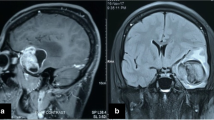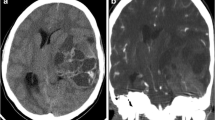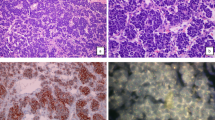Abstract
Proximal-type ES (PES) is a rare and aggressive sarcoma originated from soft tissues with uncertain differentiation. It mainly affects middle-aged patients and often locates in proximal extremity and deep-seated tissues. Only one case of PES located in the skull base has been reported to date. Herein, we report two cases of PES occurred in the middle cranial fossa in two middle-aged Chinese women. Microscopically, the tumors were consisted of epithelial-like cells with or without rhabdoid cells. And frequent mitotic activity and coagulation necrosis were present. Immunohistochemically, tumor cells in the two cases were positive for vimentin, AE1/AE3, epithelial membrane antigen (EMA), CD34, and synaptophysin. A few number of tumor cells expressed CD56. They were completely negative for integrase interactor-1 (INI1). Besides, TP53 positive cells were observed (>50%) in the two cases. The MIB-1 proliferation index was high up to 50–70%. Fluorescence in situ hybridization showed the monoallelic deletions of INI1. Intracranial PES is needed to identify with other mimic tumors, especially rhabdoid meningioma, epithelioid MPNST and adult AT/RT. The prognosis of the two patients was very poor. They died respectively less than a month and half a month after surgery. Tumor grew rapidly and was easy to infiltrate into the surrounding tissues. It may suggest that the prognosis of PES occurred at the base of skull was worse than in other sites.





Similar content being viewed by others
References
Enzinger FM (1970) Epithelioid sarcoma. A sarcoma simulating a granuloma or a carcinoma. Cancer 26:1029–1041
Chase DK, Enzinger FM (1985) Epithelioid sarcoma. Diagnosis, prognostic indicators, and treatment. Am J Surg Pathol 9:241–263
Bos GD, Pritchard DJ, Reiman HM et al (1988) Epithelioid sarcoma. An analysis of fifty-one cases. Bone and Joint Surg 70A:862–870
Guillou L, Wadden C, Coindre JM et al (1997) “Proxim al-type” epithelioid sarcoma, a distinctive aggressive neop lasm showing rhabdoid features. Clinicopathologic, immunohistochemical and ultrastructural study of a series. Am J Surg Pathol 21(2):130–146
Fletcher CDM, Unni KK, Mertens F (2002) WHO classification of tumors: pathology and genetics of tumors of soft tissue and bone. Hernational Agency for Research on Cancer (IARC) Press, Lyon, pp 205–207
dos Santos LM, Nogueira L, Matsuo CY et al (2013) Proximal-type epithelioid sarcoma - case report. An Bras Dermatol 88(3):444–447
Guzzetta AA, Montgomery EA, Lyu H et al (2012) Epithelioid sarcoma: one institution’s experience with a rare sarcoma. J Surg Res 117:116–122
Poisson JL, Rubinas TC (2010) Proximal-type epithelioid sarcoma. Labmedicine 41(8):467–470
Argenta PA, Thomas S, Chura JC (2007) “Proximal-type” epithelioid sarcoma vs. malignant rhabdoid tumor of the vulva: a case report, review of the literature, and an argument for consolidation. Gynecol Oncol 107:130–135
Hasegawa T, Matsuno Y, Shimoda T (2001) Proximal-type epithelioid sarcoma: a clinicopathologic study of 20 cases. Mod Pathol 14(7):655–663
Zevallos-Giampietri E-A, Barrionuevo C (2005) Proximal-type epithelioid sarcoma: report of two cases in the perineum: differential diagnosis and review of soft tissue tumors with epithelioid and/or rhabdoid features. Immunohistochem Mol Morphol 13(3):221–230
Tholpady A, Lonergan CL, Wick MR (2010) Proximal-type epithelioid sarcoma of the vulva: relationship to malignant extrarenal rhabdoid tumor. Int J Gynecol Pathol 29(6):600–604
Rekhi B, Gorad BD, Chinoy RF (2007) Proximal-type epithelioid sarcoma- a rare, aggressive subtype of epithelioid sarcoma presenting as a recurrent perineal mass in a middle-aged male [J]. World J Surg Oncol 5:28
Thway K, Jones RL, Noujaim J et al (2016) Epithelioid sarcoma: diagnostic features and genetics. Adv Anat Pathol 23:41–49
Lian DWQ, Lee HY, Tan KK et al (2010) Proximal type epithelioid sarcoma arising in the base of the skull: a diagnostic challenge [J]. Clin Pathol 63:472–474
Sav A, Rotondo F, Syro LV et al (2015) Invasive, atypical and aggressive pituitary adenomas and carcinomas [J]. Endocrinol Metab Clin 44(1):99–104
Rosenblum MK (2007) The 2007 WHO classification of nervous system tumors: newly recognized members of the mixed glioneuronal group [J]. Brain Pathol 17:147–149
Kreiger P, Judkins A, Russo P et al (2009) Loss of INI1 expression defines a unique subset of pediatric undifferentiated soft tissue sarcomas [J]. Mod Pathol 22:142–150
Rakheja D, Wilson KS, Meehan J et al (2005) “Prox imal-type” and classic epithelioid sarcom as represent a clinicopathologic continuum: case report [J]. Pediatr Dev Pathol 8(1):105–114
Sur M, Nayler SJ (2001) Proximal epithelioid sarcoma amisnomer[J]. Histopathology 39:641–643
Kohashi K, Izumi T, Oda Y et al (2009) Infrequent SMARCB1/INI1 gene alteration in epithelioid sarcoma: a useful tool in distinguishing epithelioid sarcoma from malignant rhabdoid tumor [J]. Hum Pathol 40:349–355
Hornick J, Dal Cin P, Fletcher C (2009) Loss of INI1 expression is characteristic of both conventional and proximal-type epithelioid sarcoma [J]. Am J Surg Pathol 33:542–550
Hornick JL, Paola DC, Fletcher CDM (2008) Loss of INI1 expression is characteristic of both conventional and proximal-type epithelioid sarcoma [J]. Am J Surg Pathol 33(4):542–550
Modena P, Lualdi E, Facchinetti F et al (2005) SMARCB1/INI1 tumor suppressor gene is frequently inactivated in epithelioid sarcomas [J]. Cancer Res 65:4012–4019
Hollmann TJ, Hornick JL (2011) INI1-deficient tumors: diagnostic features and molecular genetics. Am J Surg Pathol 35(10):e47–e63
Sápi Z, Papp G, Szendrői M et al (2016) Epigenetic regulation of SMARCB1 By miR-206, −381 and −671-5p is evident in a variety of SMARCB1 immunonegative soft tissue sarcomas, while miR-765 appears specific for epithelioid sarcoma. A miRNA study of 223 soft tissue sarcomas. Genes Chromosomes Cancer 55(10):786–802
Rosenblum MK (2007) The 2007 WHO classification of nervous system tumors: newly recognized members of the mixed glioneuronal group [J]. Brain Pathol 17:163–172
Perry A, Fuller CE, Judkins AR et al (2005) INI1 expression is retained in composite rhabdoid tumors, including rhabdoid meningiomas. Mod Pathol 18:951–958
Samaras V, Stamatelli A, Samaras E et al (2009) Atypical teratoid/rhabdoid tumor of the central nervous system in an 18-year-old patient [J]. Clin Neuropathol 28:1–10
Thway K, Fisher C (2014) Malignant peripheral nerve sheath tumor: pathology and genetics. Ann Diagn Pathol 18:109–116
Laskin WB, Weiss SW, Bratthauer GL (1991) Epithelioid variant of malignant peripheral nerve sheath tumor (Malignant Epithelioid Schwannoma). Am J Surg Pathol 15(12):1136–1145
Karkavelas G, Petrakis G, Beretouli E et al (1999) Epithelioid malignant peripheral nerve sheath tumor: report of four cases. Apmis Acta Pathologica Microbiologica Et Immunogica scandinavica 107(4):401–403
Wolf PS, Flum DR, Tanas MR et al (2008) Epithelioid sarcoma: the University of Washington experience [J]. Am J Surg 96:407–412
Guzzetta AA, Montgomery EA, Lyu H et al (2012) Epithelioid sarcoma: one institution’s experience with a rare sarcoma. J Surg Res 77:116–122
Gasparini P, Facchinetti F, Boeri M et al (2011) Prognostic determinants in epithelioid sarcoma. Eur J Cancer 47:287–295
Author information
Authors and Affiliations
Corresponding author
Rights and permissions
About this article
Cite this article
Zejun, D., Kun, Y., Dehong, L. et al. Proximal-Type Epithelioid Sarcoma in Skull Base: a Pathological Diagnosis Challenge with Other Intracranial Tumors. Pathol. Oncol. Res. 25, 201–208 (2019). https://doi.org/10.1007/s12253-017-0318-z
Received:
Accepted:
Published:
Issue Date:
DOI: https://doi.org/10.1007/s12253-017-0318-z




